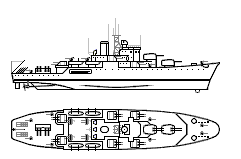
I was considering this as well. A bigger brother to Garibaldi with more beam and full double hangars. Need to accommodate more aircraft than the 60 on Garibaldi and need for heavier armament. Main changes are increased beam and draught to increase displacement. The weight is used for a bigger hangar and the 152mm duple turrets. Also designed for larger, heavier aircraft with bigger lifts and more below deck space. Port deck is offset to counteract the weight of the 152mm turrets around the island which also allowed for moving the 3rd catapult forwards. I still haven't really decided whether or not she is worth building. Has the ability to operate more and larger aircraft but is obviously more expensive than Garibaldi.
Italian Portaaerei laid down 1936
Displacement:
36,481 t light; 37,941 t standard; 44,133 t normal; 49,087 t full load
Dimensions: Length (overall / waterline) x beam x draught (normal/deep)
(913.88 ft / 885.83 ft) x 118.11 ft x (29.53 / 31.92 ft)
(278.55 m / 270.00 m) x 36.00 m x (9.00 / 9.73 m)
Armament:
10 - 5.98" / 152 mm 53.0 cal guns - 99.21lbs / 45.00kg shells, 300 per gun
Auto rapid fire guns in deck and hoist mounts, 1936 Model
4 x 2-gun mounts on sides, forward evenly spread
2 raised mounts
1 x 2-gun mount on sides, forward deck centre
1 double raised mount
56 - 1.85" / 47.0 mm 40.0 cal guns - 3.31lbs / 1.50kg shells, 4,000 per gun
Anti-air guns in deck mounts, 1936 Model
14 x Quad mounts on sides, evenly spread
Weight of broadside 1,177 lbs / 534 kg
Armour:
- Belts: Width (max) Length (avg) Height (avg)
Main: 5.91" / 150 mm 492.13 ft / 150.00 m 9.84 ft / 3.00 m
Ends: 1.42" / 36 mm 393.70 ft / 120.00 m 9.84 ft / 3.00 m
Upper: 1.42" / 36 mm 492.13 ft / 150.00 m 49.21 ft / 15.00 m
Main Belt covers 85 % of normal length
- Torpedo Bulkhead:
1.57" / 40 mm 492.13 ft / 150.00 m 26.25 ft / 8.00 m
- Gun armour: Face (max) Other gunhouse (avg) Barbette/hoist (max)
Main: 5.31" / 135 mm 2.76" / 70 mm 2.76" / 70 mm
2nd: 0.39" / 10 mm 0.39" / 10 mm -
- Armoured deck - multiple decks: 1.57" / 40 mm For and Aft decks
Forecastle: 1.57" / 40 mm Quarter deck: 1.57" / 40 mm
- Conning towers: Forward 2.76" / 70 mm, Aft 0.00" / 0 mm
Machinery:
Oil fired boilers, steam turbines,
Geared drive, 4 shafts, 180,000 shp / 134,280 Kw = 32.80 kts
Range 6,900nm at 25.00 kts
Bunker at max displacement = 11,146 tons
Complement:
1,522 - 1,979
Cost:
£11.181 million / $44.722 million
Distribution of weights at normal displacement:
Armament: 508 tons, 1.2 %
Armour: 6,103 tons, 13.8 %
- Belts: 2,967 tons, 6.7 %
- Torpedo bulkhead: 753 tons, 1.7 %
- Armament: 178 tons, 0.4 %
- Armour Deck: 2,130 tons, 4.8 %
- Conning Tower: 74 tons, 0.2 %
Machinery: 5,051 tons, 11.4 %
Hull, fittings & equipment: 14,996 tons, 34.0 %
Fuel, ammunition & stores: 7,652 tons, 17.3 %
Miscellaneous weights: 9,824 tons, 22.3 %
- Hull below water: 500 tons
- On freeboard deck: 5,500 tons
- Above deck: 3,824 tons
Overall survivability and seakeeping ability:
Survivability (Non-critical penetrating hits needed to sink ship):
124,818 lbs / 56,616 Kg = 1,164.9 x 6.0 " / 152 mm shells or 24.0 torpedoes
Stability (Unstable if below 1.00): 1.21
Metacentric height 9.2 ft / 2.8 m
Roll period: 16.4 seconds
Steadiness - As gun platform (Average = 50 %): 76 %
- Recoil effect (Restricted arc if above 1.00): 0.04
Seaboat quality (Average = 1.00): 1.52
Hull form characteristics:
Hull has raised forecastle,
a normal bow and large transom stern
Block coefficient (normal/deep): 0.500 / 0.514
Length to Beam Ratio: 7.50 : 1
'Natural speed' for length: 34.79 kts
Power going to wave formation at top speed: 51 %
Trim (Max stability = 0, Max steadiness = 100): 50
Bow angle (Positive = bow angles forward): 20.00 degrees
Stern overhang: 6.56 ft / 2.00 m
Freeboard (% = length of deck as a percentage of waterline length):
Fore end, Aft end
- Forecastle: 12.00 %, 59.06 ft / 18.00 m, 59.06 ft / 18.00 m
- Forward deck: 40.00 %, 26.57 ft / 8.10 m, 26.57 ft / 8.10 m
- Aft deck: 33.00 %, 26.57 ft / 8.10 m, 26.57 ft / 8.10 m
- Quarter deck: 15.00 %, 26.57 ft / 8.10 m, 26.57 ft / 8.10 m
- Average freeboard: 30.47 ft / 9.29 m
Ship space, strength and comments:
Space - Hull below water (magazines/engines, low = better): 52.7 %
- Above water (accommodation/working, high = better): 241.1 %
Waterplane Area: 72,492 Square feet or 6,735 Square metres
Displacement factor (Displacement / loading): 161 %
Structure weight / hull surface area: 154 lbs/sq ft or 752 Kg/sq metre
Hull strength (Relative):
- Cross-sectional: 1.05
- Longitudinal: 1.33
- Overall: 1.08
Hull space for machinery, storage, compartmentation is excellent
Room for accommodation and workspaces is excellent
Ship has slow, easy roll, a good, steady gun platform
Excellent seaboat, comfortable, can fire her guns in the heaviest weather
Warning: Armour belts too tall for hull
100mm deck armour 150x30 = 3524tons
Proof against 1500lb bombs from dive bombers
72 aeroplanes = 5200tons + 12 spares = 300t
extra 750,000L AVGAS = 540tons
4x450mm extra torpedoes per aircraft = 182tons
8x500kg extra bombs per aircraft = 288tons
100 tons flag facilities
100 tons radars/comms


Quoted
Do you really need all that length?
Quoted
I can't say I care for your funnel arrangement,Quoted
does the "A" twin 6" mount actually have sufficient field of fire to merit the top weight?Quoted
I am concerned that at 36m beam, the ship is not Panamax.Quoted
It's a very interesting vessel. Lots of protection vs. airgroup. Which may be reasonable.